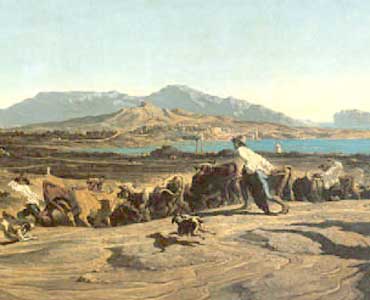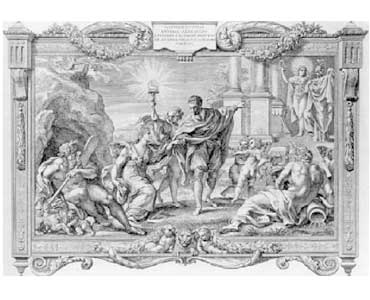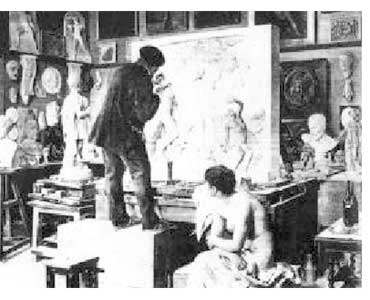|

ref:2003/1
(1)
Leaving
L'Estaque: Cézanne's Imagery of Provence in the 1880s
Jonathan
Kear
Department of History and Theory of Art
Rutherford College, University of Kent, CT2 7EN, England
J.Kear@ukc.ac
Keywords:
Cezanne, L'Estaque, nineteenth-century French painting, Provence,
Montagne Sainte-Victoire, landscape painting

Abstract
Traditionally,
Cézanne's landscape painting has been accounted for
exclusively in terms of the evolution of the painter's technique.
His pictures of L'Estaque have been regarded as preparing
the way for his mature style of painting that culminates in
the pictures of the Montagne Sainte-Victoire. This article
argues for an alternative approach to Cézanne's landscapes
which points to crucial shifts in his selection of motifs,
shifts that divide his earlier and later painting. Focusing
on the different types of landscape subject Cézanne
painted it demonstrates how his choice of motif was reworked
in relation to different traditions and conceptions of landscape
painting associated with his native Provence. Rather than
seeing the L'Estaque pictures as a prelude to his subsequent
paintings of Provence, it suggests they represent a short-lived
moment when Cézanne overtly engaged with modern motifs
in a fast developing industrial region. His later paintings
of Provence mark a decisive break with this modernity and
the cultivation of a more traditional and nostalgic vision
of the region.


ref: 2003/1 (2)
Finding
Ovid through Raphael in the Schools of the Tombs
Ben
Thomas
School of Drama, Film and Visual Arts, Rutherford College,
University of Kent, Canterbury, CT2 7NX
b.d.h.thomas@kent.ac.uk
Keywords:
Raphael, Nicolas Poussin, Ovid, Giovan Pietro Bellori, Pietro
Santi Bartoli, mural painting, tomb painting, Schools of the
Tombs

Abstract
In
1674 a tomb decorated with murals was discovered on the Via
Flaminia in Rome, which on the basis of inscriptions was wrongly
identified as Ovid's tomb. Pietro Santi Bartoli, an ardent
frequenter of the 'schools of the tombs', preserved the mural
designs in prints published in 1680 as Le pitture antiche
del sepolcro de' Nasoni. These prints form part of Bartoli's
dual project to record the vestiges of Roman art and to recover
the parergonal elements of Raphael's works; a dialogue between
ancient and modern in which differences of historical context
and artistic accomplishment were effaced by the bland reproductive
style of the etchings. Bartoli's prints of the tomb paintings
were accompanied by a remarkable iconographical exegesis by
Giovanni Pietro Bellori, in which he identified Ovid's portrait
and elucidated the pictorial cycle's concern with the soul's
journey after death. The similarities with Bellori's readings
of picture cycles by Raphael, Annibale Carracci and Nicolas
Poussin are discussed here, together with the theme of the
tomb in his writings.


ref:
2003/1 (3)
Modern
muses: representing the life model in fin de siecle France
Claire
O'Mahony
Department of the History of Art, University of Bristol, 43
Woodland Road, Bristol BS8 1UU
Claire.OMahony@bristol.ac.uk
Keywords:
Jean Léon Gérôme, Henri Fantin-Latour,
Georges Seurat, artist's model, artist's studio, nineteenth-century
French painting

Abstract
Artistic
inspiration has often been represented by the allegorical
figure of a muse. Painters and critics of the 1860s who embraced
the 'painting of modern life' seemed to have been dissatisfied
with the archaism of a muse of truth, yet to be equally wary
of depicting the life model as the representative of inspiration.
This unease was renegotiated in the pocket books, novels and
Salon paintings of the 1880s and 1890s. In these works, distancing
structures of ethnicity and objectification served to neutralise
the uncomfortable implications of representing the artist/model
relationship. The space of the studio was demarcated as the
irreproachable workplace of the artist in which the artist's
gaze, and that of the implicit viewer, was granted a certain
impunity. The studio scene with a nude female model in its
midst appeared frequently in the Salons of the 1880s and 90s.
This legitimisation of the gaze allowed these works to create
a new form of high art erotica. Like Bacchante and seraglio
scenes, the fantasy world of the studio allowed erotic visual
imagery, even including the taboo juxtaposition of the clothed
and the naked, to pass, though perhaps anxiously, on to the
walls of the Salon. The 'modern' nudes of Seurat's Les
Poseuses in their self-proclaimed art poses undermined
the easy voyeurism these images had allowed. However, by thus
invoking the model as a modern muse, this work nonetheless
foregrounds the artist's solipsism rather than the life model
as a social, creative being.


ref:2003/1 (4)
Local
defence volunteer: the painting and criticism of Edward Baird
1939-1945
Jonathan
Blackwood
School of Humanities and Social Sciences, University of Glamorgan,
Pontypridd, CF37 1DL, Wales
jblackwo@glam.ac.uk
Keywords:
Edward Baird, Scottish art, art of the Second World War, Scottish
Renaissance, Montrose, Committee for the Encouragement of
Music and Art (CEMA), nationalist, war, identity
Abstract
The
paper outlines the circumstances of Edward Baird's career
and focuses in particular on his work completed in Montrose
during the Second World War.
Three
paintings in particular are analysed closely. In LDV, Montrose
from Ferryden, and Unidentified Aircraft, we see
the emergence of an aesthetic that can be considered as part
of a 'British' artistic response to the war. However, the
works are double coded. We can also analyse them in terms
of their reflections on contemporary Scottish identity, and
of the urban and rural working classes who shouldered the
burden of the war effort.
It
is suggested in conclusion that these paintings, seen together,
provide a discrete Scottish contribution to the British war
effort, emblematic of an outlook that anticipated re-engagement
with the European mainstream, in Scottish terms, in the post
war period.

|
|


